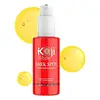What's inside
What's inside
 Key Ingredients
Key Ingredients

No key ingredients
 Benefits
Benefits

 Concerns
Concerns

No concerns
 Ingredients Side-by-side
Ingredients Side-by-side

Water
Skin ConditioningButylene Glycol
HumectantGlycerin
HumectantNiacinamide
SmoothingKojic Acid
AntioxidantPhenoxyethanol
PreservativeTriethanolamine
BufferingCarbomer
Emulsion StabilisingPotassium Methoxysalicylate
BleachingChlorphenesin
AntimicrobialAllantoin
Skin ConditioningBetaine
HumectantTetrasodium EDTA
Propanediol
SolventSodium Hyaluronate
HumectantSaccharomyces/Viscum Album Ferment Extract
Skin ConditioningLactobacillus/Soybean Ferment Extract
Skin Conditioning1,2-Hexanediol
Skin ConditioningSaccharomyces/Imperata Cylindrica Root Ferment Extract
EmollientXanthan Gum
EmulsifyingCaprylyl Glycol
EmollientPentasodium Tetracarboxymethyl Acetylhydroxyprolyl Dipeptide-12
Skin ConditioningLecithin
EmollientSh-Oligopeptide-1
Skin ConditioningSh-Oligopeptide-2
Skin ConditioningSh-Polypeptide-1
Skin ConditioningSh-Polypeptide-11
Sh-Polypeptide-9
Skin ConditioningSodium Phosphate
BufferingTripeptide-29
Skin ConditioningPentasodium Tetracarboxymethyl Dipeptide-51
Skin ConditioningGlucose
HumectantChondrus Crispus Extract
Skin ConditioningOligopeptide-68
BleachingGlycine Soja Oil
EmollientHydrogenated Lecithin
EmulsifyingHydroxypropyltrimonium Hyaluronate
Hydrolyzed Hyaluronic Acid
HumectantSodium Acetylated Hyaluronate
HumectantHyaluronic Acid
HumectantHydrolyzed Sodium Hyaluronate
Skin ConditioningSodium Hyaluronate Crosspolymer
HumectantPotassium Hyaluronate
Skin ConditioningWater, Butylene Glycol, Glycerin, Niacinamide, Kojic Acid, Phenoxyethanol, Triethanolamine, Carbomer, Potassium Methoxysalicylate, Chlorphenesin, Allantoin, Betaine, Tetrasodium EDTA, Propanediol, Sodium Hyaluronate, Saccharomyces/Viscum Album Ferment Extract, Lactobacillus/Soybean Ferment Extract, 1,2-Hexanediol, Saccharomyces/Imperata Cylindrica Root Ferment Extract, Xanthan Gum, Caprylyl Glycol, Pentasodium Tetracarboxymethyl Acetylhydroxyprolyl Dipeptide-12, Lecithin, Sh-Oligopeptide-1, Sh-Oligopeptide-2, Sh-Polypeptide-1, Sh-Polypeptide-11, Sh-Polypeptide-9, Sodium Phosphate, Tripeptide-29, Pentasodium Tetracarboxymethyl Dipeptide-51, Glucose, Chondrus Crispus Extract, Oligopeptide-68, Glycine Soja Oil, Hydrogenated Lecithin, Hydroxypropyltrimonium Hyaluronate, Hydrolyzed Hyaluronic Acid, Sodium Acetylated Hyaluronate, Hyaluronic Acid, Hydrolyzed Sodium Hyaluronate, Sodium Hyaluronate Crosspolymer, Potassium Hyaluronate
 Reviews
Reviews

Ingredients Explained
These ingredients are found in both products.
Ingredients higher up in an ingredient list are typically present in a larger amount.
1,2-Hexanediol is a synthetic liquid and another multi-functional powerhouse.
It is a:
- Humectant, drawing moisture into the skin
- Emollient, helping to soften skin
- Solvent, dispersing and stabilizing formulas
- Preservative booster, enhancing the antimicrobial activity of other preservatives
Butylene Glycol (or BG) is used within cosmetic products for a few different reasons:
Overall, Butylene Glycol is a safe and well-rounded ingredient that works well with other ingredients.
Though this ingredient works well with most skin types, some people with sensitive skin may experience a reaction such as allergic rashes, closed comedones, or itchiness.
Learn more about Butylene GlycolGlycerin is already naturally found in your skin. It helps moisturize and protect your skin.
A study from 2016 found glycerin to be more effective as a humectant than AHAs and hyaluronic acid.
As a humectant, it helps the skin stay hydrated by pulling moisture to your skin. The low molecular weight of glycerin allows it to pull moisture into the deeper layers of your skin.
Hydrated skin improves your skin barrier; Your skin barrier helps protect against irritants and bacteria.
Glycerin has also been found to have antimicrobial and antiviral properties. Due to these properties, glycerin is often used in wound and burn treatments.
In cosmetics, glycerin is usually derived from plants such as soybean or palm. However, it can also be sourced from animals, such as tallow or animal fat.
This ingredient is organic, colorless, odorless, and non-toxic.
Glycerin is the name for this ingredient in American English. British English uses Glycerol/Glycerine.
Learn more about GlycerinWater. It's the most common cosmetic ingredient of all. You'll usually see it at the top of ingredient lists, meaning that it makes up the largest part of the product.
So why is it so popular? Water most often acts as a solvent - this means that it helps dissolve other ingredients into the formulation.
You'll also recognize water as that liquid we all need to stay alive. If you see this, drink a glass of water. Stay hydrated!
Learn more about Water